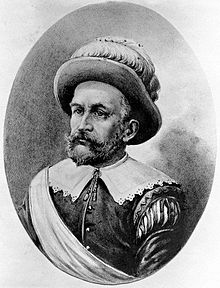On this day in history, a representative of the Dutch West India Company, Peter Minuit, arrived on the island of Manhattan in New York to oversee the company’s trading and colonizing activities in the Hudson River area. The Dutch had already established a town called New Amsterdam at the southern end of the island, but Minuit’s trade of sixty guilders’ worth of trinkets sealed the deal for the rest of the island.
New Amsterdam was known as a pretty wild trading post, rife with smuggling and tax evasion. In 1647, the Dutch West India Company sent Peter Stuyvesant to crack down on the town. In the seventeen years of his administration, he got a school, post office, hospital, and prison built, and had a barricade erected again the Indians and the British on the site of what is now Wall Street, giving the avenue its current name.

The original city map of New Amsterdam called Castello Plan from 1660 (the bottom left corner is approximately south, while the top right corner is approximately north)
In 1664, the first year of the sea war between England and Holland, Stuyvesant was forced to surrender the town to the British. The British divided the New Netherland territory into the colonies of New York and New Jersey, and renamed New Amsterdam to New York City in honor of England’s Duke of York. Many other Dutch towns would be merged into New York City, including Breukelen (Brooklyn), Vlissingen (Flushing), and Nieuw Haarlem (Harlem).
Although the Dutch briefly recaptured New York in 1673 and renamed it New Orange, they had to cede the territory once again pursuant to Anglo-Dutch Treaty of Westminster in 1674, and New Orange was once again New York. By 1690, it was the third-largest town in North America (with a population of just under 4,000).
New York City was controlled by the British until the American Revolution. After New York ratified the U.S. Constitution in 1788, New York City was named the state capital until 1797, and even served as the capital of the United States for eighteen months in the period 1789-1790. By 1790, the population had grown to 33,000.
New York City’s population as of 2010 was tallied at 8,175,133. The population estimate by the U.S. Census as of July 1, 2023 was 8,335,897. The city consists of five boroughs – four besides Manhattan – and is the largest in the United States.

New York City was particularly hard hit by the COVID pandemic. You can see the latest statistics here including data by borough.





Leave a comment